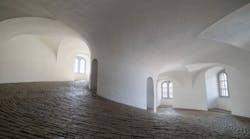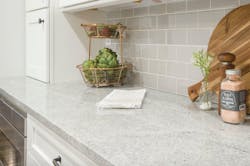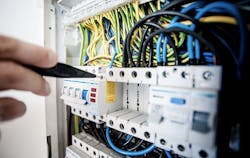40 Ways to Build a Better House, Part 2
This is Part 2 in a series on how to build a better house. Click here to read Part 1.
21. Constant Communication
Construction scheduling is now an area of rapid, almost frenzied, innovation as builders search for the best ways to apply new electronic communication technologies to the challenge of getting materials and right-sized trade crews to a job site exactly when they are needed. Drees seems to be in the lead.
Jack Herbstreit is collaborating with Atlanta consultant John West of IntelliNet to develop "DreesBuild," an internet-based scheduling system that will allow trade crews, suppliers, manufacturers and even customers to check on the status of every house under construction every day. And as if that weren’t enough, DreesBuild also has report-generating capability.
"I can get reports that tell me when vendors are late and why," says Herbstreit. "There’s a forecasting report that tells me when a sub or supplier is becoming overloaded and can’t handle more work."
What drives the reporting capability? Drees’ superintendents ("builders") are learning to fill in fields on the computer screen, every day, with "reason codes" that describe why a crew was late or didn’t show up, or why a supplier missed a delivery.
"The best part about this is, it’s on the Internet, so anybody can access it," says Herbstreit. "So now our scheduling system, which used to be a big secret, is right on the Internet, and any trade or supplier can get into that web site and get that information."
What about the competitors who will also be able to see it? "We don’t care," says Herbstreit. "Having this information available to the people who need it will probably cut the number of phone calls our builders have to make each day in half."
22. More Natural Light
"One of the things that I am noted for is using a lot of day light," says Edward O. Paschich. "The way I do that is simply use bigger windows and add skylights."
Certainly the cost of adding window lighting is a factor to be aware of, he says, but is only marginal when one considers the benefit to homeowners. His process for adding daylight to a home is quite specific. He goes for a 50 percent increase in window area over what is required in the Universal Building Code. The UBC states that windows must comprise 10 percent of the square footage of a room. For a 12-by-12-foot room with 144 square feet of space, the window area is required to be at least 14 feet 5 inches in area. To Paschich the same room is much improved with approximately 22 square feet of total window area. As a rule of thumb, he estimates that for every 10 percent of light area added over the size required in UBC, the window cost for that room increases 5 percent.
Whenever possible, Paschich also adds skylights. Placement is key. He puts them in bathrooms over vanities and in hallways near doorways. That way daylight is added to the hallway and to adjacent rooms.
"I like to have at least three sources of daylight in most rooms," Paschich says.
23. Invest in HVAC
Convincing buyers to install more expensive HVAC equipment and other mechanicals isn’t all that difficult if you demonstrate the value and increased comfort they will enjoy as a result.
"Such things as remote in-line fan units in bathrooms aren’t really that much more expensive," says John Crowley, president of New England Classic Interiors in Portland, Maine.
Crowley worked as a builder and was the former director of the Innovative Construction Technology Center at the Massachusetts Institute of Technology before founding his current company, which manufactures modular decorative panel systems. He firmly believes that when consumers realize that quieter and more efficient appliances and mechanicals are cheaper in the long run, better for the environment and result in a healthier and more peaceful home, they have no problem paying a marginal premium.
24. Set Aside Topsoil
A little foresight and planning in the excavation phase can also help builders save time, increase profits and build a better home. Toll Brothers scrapes the topsoil where they will be digging and deposits it strategically for later landscaping use.
"We also try to pile the excavated dirt on the high side of the site and form a berm to divert rainwater away from the foundation," says Webber. "This results in a drier, cleaner worksite during the early stages."
25. Sealing and Ventilation as a System
As homes continue to become more and more airtight for increased energy efficiency, indoor air quality is becoming an ever-increasing concern—the American Lung Association (ALA) reports that indoor air pollutants can reach levels as much as 10 times higher than outdoor air pollutants.
The solution, says Vernon McKown of Ideal Homes in Norman, Okla.—a company committed to building according to the ALA’s Health House criteria—is to think of sealing and ventilation as a system.
To prevent air and moisture infiltration, houses need to be sealed properly. This means using mastic on all duct joints, caulking or using expandable foam (rather than chinking) around windows, caulking around soleplates and sealing knee walls properly with polystyrene board and expandable foam.
For proper ventilation, McKown uses a continuous ventilation system, which consists of a low-noise emitting vent fan and an air cycler. He uses one by Panasonic and places it in the master bathroom where a lot of the moisture accumulates. It runs continuously, venting 50 cubic feet of air per minute.
The air cycler is a wiring control connected to the furnace that uses the heat distribution system to help move air around within the house, thus making the fan more efficient and preventing the build-up of moisture and pollutants in pockets of the house. In the homes McKown builds, the cycler is programmed to come on ten out of every 20 minutes, but he said that 15 minutes out of every hour is sufficient.
In addition, McKown uses jumper grills, which are vents with an 89 duct that runs up and over the rafter above the door between two rooms, to eliminate negative pressurization.
26. Higher Architectural Intent
"The successful builder is usually one that finds ways to add architectural intent without a lot of cost," notes Edward O. Paschich. Over the past few years he has become an advocate of using injected plastic moldings, trim and columns. These products, he says, are looking more real, easier to install, and cost less than in years past. But Paschich takes it one step further.
He believes that people have an innate sense of mass. For that reason he fills hollow architectural columns with sand. It is a small detail that will make a difference to those who might happen to touch or lean against it for years after the home is occupied.
It is important to check to make sure that the columns used are strong enough to hold the sand. Several manufacturers offer such products. Paschich uses ones that are made with urethane.
27. Eliminate Avenues for Termites
Termites are a big problem in many areas of the country, especially Southern states like Louisiana and South Carolina, where ferocious Formosan termites are entrenched and wreaking havoc. Gainesville, Fla., builder Barry Rutenberg, who is also the current president of Florida Home Builders Association and a major force at the national level in NAHB, has come up with some ideas to defuse termite problems.
"Most builders still leave wood grade stakes (usually 18 inches long) in the concrete after they pour footers," says Rutenberg. "That’s an interstate highway for termites right into the house. I also see stakes and form boards left around bathtubs. We’re being a lot more careful today to make sure that there are no avenues like that for termite penetration into the houses we build."
28. Granite Tile
John Crowley points to granite tile as one way builders can provide the look and feel of high-end slab countertops at about half the cost. While installation is more labor-intensive, it is more forgiving of inaccurate measurements and still saves a bundle of money.
"They are also stock items. There is no need to special order or have them shipped," says Crowley. Other production products with that high-end or custom look are rigid polystyrene foam crown moldings and accents or modular raised-panel systems. "Many of these items are inexpensive and very easy to install," says Crowley. "And with today’s manufacturing technology, they look extremely authentic."
29. Properly Seal A/C Returns
Interior air quality has become a concern across the country. Mike Humphrey believes the point of greatest vulnerability is air conditioning returns.
"If that return is not sealed properly, the system is pulling inside air and re-circulating it, rather than outside air, as designed. It’s an issue today because of the shortage of skilled tradesmen available to us, and because of the declining quality of materials—especially wood—with which we are working. We’ve made properly sealed A/C returns a major point of inspection."
30. Laser Levels
"Laser levels can be an invaluable tool when installing kitchen cabinets, moldings, trims, wainscoting and setting the grade lines for exterior siding," adds John Crowley. "They really speed up the layout process and improve accuracy."
31. Perfect the Painting Process
At David Weekley Homes, warranty service histories showed that painting was perhaps its most flawed operation. In response, painters are required to fill touch-up kits as they work (later passed on to buyers) with small amounts of each of the paints used on the house. If a need for touch-up arises after closing, the buyer has prepping materials and paint to match every surface.
Weekley also specifies every paint product, by name and number, used in each city where it operates. "We have a specific paint manufacturer that we select in each city," says Mike Humphrey. "Then we work with that manufacturer to design a paint program—including every step from preparation, to primer, to top coat. We also have the paint manufacturer send representatives to spot-check for the right products and mil coverage in the field."
32. Consider Blown-In Insulation
For the past five years, noted Colorado building company McStain Enterprises has been using blown-in cellulose as its primary insulating material. Though the product is about 25 percent more expensive than traditional fiberglass insulation, the benefits outweigh the cost says Patrick Murphy, vice president of construction for McStain.
For one thing, R-values of walls after they have been insulated with cellulose often exceed 20, making homes highly energy efficient. Secondly, cellulose insulation provides a vapor barrier tight enough to eliminate the need for house wrap products. Lastly, the product is very "green."
According to McStain’s director of environmental programs Kristin Shewfelt, cellulose insulation is made from 90 percent recycled material, mainly newsprint and corrugated boxes. Because of this, the product is also treated with a fire retardant.
Shewfelt also points out that the cost of using cellulose has dropped significantly since McStain first began using it. It initially cost, she says, about 100 percent more than fiberglass insulating systems. But the price of the material and the rising learning curve of installation crews have gradually lowered much of the difference.
33. Reduce Drywall Cracks
David Weekley Homes has written additional corner blocking into specs in all markets where wood frame construction is standard practice. "We’ve seen more (drywall) cracking in corners of late," says Humphrey, "so we are taking this step to try to head off a problem."
34. Fiber-Cement Siding
John Crowley applauds fiber-cement siding because of its durability, versatility and because installers can completely blind-nail it, leaving a more professional looking job. He stresses that using saw blades manufactured specifically for this product and special hand-held shears make installation much easier and provide better results.
"I would not store it on the job site, however," Crowley says. "If it lays flat and absorbs moisture, it’s ruined."
35. Soundproof Interior Walls
John Crowley of New England Classic Interiors, stresses insulating interior walls for soundproofing as another extra that buyers appreciate. Extra care should be given to the walls that separate the bathrooms from the rest of the house, especially in the plumbing walls adjacent to the master bedroom.
"And don’t forget to use acoustical caulk or any durable, elastic caulking material on the bottom and top plates where they meet the floor and ceiling, and between the door frame and the jambs," says Crowley.
36. Upgraded Communication Wiring
For many years there has been a lot of talk about home networks, smart homes and appliances that communicate wirelessly. Builders have been rightly cautious on many of these concepts, letting buyer preferences drive the marketplace. At this point, however, more builders are finding that better homes include upgrades in the type and amount of communications wiring.
For Holt & Haugh, a robust and branded system offered by Home Director Inc. is one way to build a more connected home. Aside from a massive structured wiring package, the PC-based system offers greater control of major home mechanical systems like HVAC and lighting.
Shea Homes San Diego is taking a similarly aggressive approach to technology. For the past two years, 90% of the company’s new homes include a full structured wiring package as standard. The cost to the builder is between $1,000 and $1,500 per home. Within the next six months, the company plans to offer more powerful control systems tied into the electrical systems at a cost of $5,500 per home, says division marketing manager Teri Shusterman.
"We are not used to spending money on such things without proof that buyers want them," notes Shusterman. "But in the area of technology, we have to really stay ahead of the customer because they really don’t know what is coming around the corner."
Despite discussion of coming wireless networking, better homes will include upgraded communication wiring. Structured wiring systems are sold by a number of manufacturers and distributors, but typically they meet the minimum requirements championed by an industry group called Wiring America’s Homes. Recommended minimum wiring is as follows:
• A central distribution box, usually located in the basement or central utility room to which all cabling is "home run."
• One four-pair of UTP Category 5 cable. This high-speed telephone cable, handles high-speed Internet connections and some audio and video functions.
• One RG-6 coaxial cable to key rooms in the house. In addition to cable TV applications, the cable can be used to distribute satellite TV and closed-circuit TV images to TVs and computer screens around the home.
• The cables should be connected in a "Star" topography providing direct connections from each wall jack to the central distribution box.
• Universal service outlets that can accommodate voice, data and video applications.
37. Cast Iron Waste Pipes
Quieter mechanicals in homes make for a better home. With that in mind, Holt & Haugh began looking for ways to reduce the noises in the homes they build. They started with quieter brands of HVAC systems and finally came to realize that a lot of water noise is generated within walls when PVC piping is used in sanitation pipes. With PVC you can often hear water from toilet flushes and showers, in particular, Kate Gillespie says.
Cost is certainly a factor, but the company soon began specifying traditional cast iron waste pipes instead of PVC. "Our customers seem to recognize the difference this change makes," she says.
38. Keep Mulch Away From the House
A big problem in North Florida, according to Barry Rutenberg, is people re-mulching houses and bringing the material up too close to the siding on wood-framed houses. "That mulch needs to be at least six to eight inches away from the bottom of the siding," says Rutenberg. "It can be a construction problem if the house is not built high enough to get that positive grade. We make sure to keep all banding and trim components at least 8 inches above grade."
For the most part, though, Rutenberg sees this as an education problem:
"If you don’t inform home buyers of the problem, they just don’t understand. We keep going back to check on people. Our salespeople visit several times in the first two months of occupancy, and I visit every buyer personally at 90 days after closing. How high to keep mulch is not the primary purpose of the visit, but I mention it."
39. Put Ducts in Air Conditioned Space
Barry Rutenberg also believes energy efficiency is another area to which builders should pay special attention: "It’s one thing to really differentiate new homes from used ones," he says. "I’m amazed at what buyers are willing to pay now for upgraded mechanical systems and reduced air infiltration. We have a high-end community here in Gainesville where the neighbors all compare notes on who has the most energy-efficient house. It’s not who has the biggest SUV; it’s who has the smallest electrical bill."
Toward that end, Rutenberg is now building many houses with all of the ducting in air-conditioned space, instead of the standard practice of pushing cold air through ducts in the hot attic. Rutenberg also has a house with the utility room in the center of the floor plan, to cut the length of ducting runs. "It’s for an architect," says Rutenberg. "He’s also going to have three separate zones in the house, and a variable speed HVAC system that will run with either 2.5- or 5.0-ton capacity. Most of the time, it will run as a 2.5-ton unit, which is much more efficient."
40. Basement Solution for Clay Soils
Many of the Rocky Mountain states are home to soils that are high in clay content. And as most home builders know, these soils have the tendency to expand and contract more than other types. The affected area runs from Montana down through parts of Texas and from Colorado west through parts of Nevada.
This temperature-related expansion and contraction of the soil requires builders to use elevated wood floors as a solution for basements. The problem with this solution, says James Leonard of McStain Enterprises, is the expense and hassle related to venting the moisture that gathers underneath the floor. Fans and vents are needed. That is why McStain has pioneered an elevated concrete floor solution that remains sealed after it is constructed.
The solution is similar to the process used in the construction of decks in commercial structures, says Leonard. After the footings are in place, a six-inch thick cardboard slab is laid. On top of that is laid a more rigid fiberboard surface on which rebar can be constructed before the floor is poured.
The benefits of this "structural flooring" system are many. The basement is completely sealed from undue moisture associated with wood floors. And, because the use of space beneath the floor is smaller than what is required for wood floors, foundation walls can be 98 tall instead of 108, with the same 7889 resulting ceiling height.



